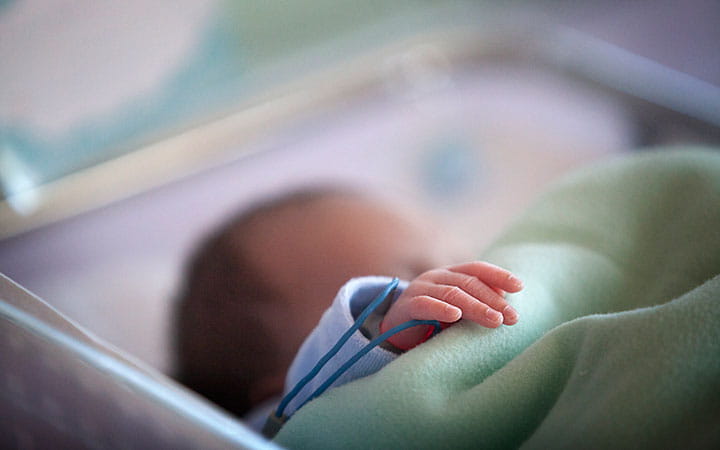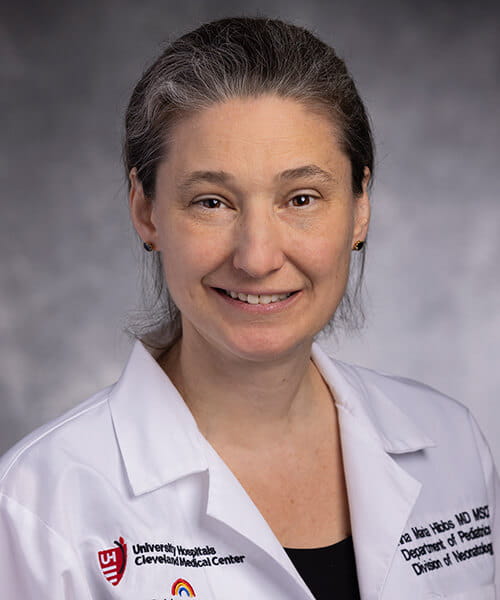Collaborative Multidisciplinary Approach to Clinical Care and Research Fuel Advances at University Hospitals Rainbow & Babies, a Leading Neonatology Program Worldwide
June 23, 2025


For more than 100 years physicians and researchers at University Hospitals Rainbow Babies & Children’s have been at the forefront of pediatric care, leveraging rich clinical expertise and a full spectrum of collaborative, multidisciplinary research to increase evidence-based practices and advance neonatal care worldwide.
UH Rainbow is among the top neonatology programs in the country, ranked 9th in the nation, according to the 2024-2025 U.S. News & World Report Best Children’s Hospitals list, and our neonatal intensive care unit (NICU) is among the best in the country, with some of the highest survival rates. Our proximity to a globally recognized academic medical center, University Hospitals of Cleveland, ensures patients receive the best care possible, with access to the latest medical advances.
Research is integral to what we do. Our longstanding tradition of innovation and quality care are transforming medical outcomes, improving quality of life for patients born prematurely, and mitigating the long-term health effects of pre-term births. We foster greater understanding of underlying disease mechanisms to develop new, potentially transformative treatments.
“Our multitalented team of scientists, researchers, and caregivers are uniquely positioned to conduct high-quality trials and develop novel medical interventions and practices for the neonatal populations,” says Anna Maria Hibbs, MD, MSCE, FAAP, Vice Chair of Research at UH Rainbow and Professor of Pediatrics, Case Western Reserve University School of Medicine.
 Anna Maria Hibbs, MD, MSCE, FAAP
Anna Maria Hibbs, MD, MSCE, FAAPUH Rainbow has a comprehensive bench-to-bedside research program, encompassing basic lab studies and biomarker identification, in addition to translational and clinical research, including clinical trials, and growing health services research. The research program’s follow-up expertise and focus on long-term neurodevelopmental and pulmonary outcomes have fueled a robust body of high-quality research, to better understand breathing complications that preterm infants can develop, including neurodevelopmental impairment, asthma, and bronchopulmonary dysplasia.
Building Upon a Longstanding History of Clinical Expertise and Fast-evolving Research
UH Rainbow’s principal investigators have a rich tradition of modeling neonatal disease in the basic science laboratory to explore potential mechanisms underlying numerous NICU outcomes and to test novel therapies. Basic researchers partner with clinical researchers for a bench-to-bedside approach to disease.
For decades, UH Rainbow neonatology experts have worked to pinpoint the links between the interventions babies receive and their long and short-term outcomes, pioneering treatments and advancing the international standard of care for preterm infants. UH Rainbow was among the first hospitals in the country, and the first hospital in Ohio, to offer extracorporeal membrane oxygenation in 1987 and inhaled nitric oxide for pulmonary hypertension (1990s), among other emerging therapies, elevating the standard care for newborns with breathing problems. Likewise, our research and clinical team have advanced therapeutic hypothermia, or cooling, for hypoxic-ischemic encephalopathy in newborns, to protect babies from brain damage caused by oxygen deprivation.
Additionally, our scientific team has also helped define and develop new standards of care for treating neonatal abstinence syndrome. They similarly were among the first to promote the benefits of family-centered care, a practice that has been adopted by many other hospitals around the country.
UH Rainbow’s Team Highly Dedicated Clinicians and Scientists Discover, Innovate, Save Lives
Current research studies underway at UH Rainbow include Pragmatic Research on Diuretic Management in Early BPD, a multiple principal investigator (MPI) study led at UH Rainbow by Dr. Hibbs and Heather Kaplan, MD at Cincinnati Children’s Hospital, to increase the evidence base for using diuretics in the treatment of BPD. These drugs are frequently used to treat infants at risk of developing BPD, despite limited evidence on their benefit.
Dr. Hibbs is also a PI for “Post-Vent, the Sequelae: Personalized Prognostic Modeling for Consequences of Neonatal Intermittent Hypoxemia (IH) in Preterm Infants at Pre-school Age,” a collaboration between five clinical centers to examine oxygenation and control of breathing patterns and their impact on long-term respiratory outcomes. The study builds off a previous study, examining the effects on neonatal interventions among children ages five through seven, including asthma, sleep-disordered breathing, and neurodevelopmental impairment. The Post-Vent study combines detailed clinical phenotyping and advanced analytics of longitudinal recordings intermittent hypoxia (IH) events to create prognostic models of long-term outcomes to enable timelier identification of at-risk infants and IH patterns for future targeted prevention or therapeutic trials. Work on the cohort at UH Rainbow has already shown links between IH patterns and outcomes such as length of hospitalization, high blood pressure, respiratory outcomes, and neurodevelopment.
 Deanne Wilson-Costello, MD
Deanne Wilson-Costello, MDAdditionally, Deanne Wilson-Costello, MD, Director of the High-Risk Follow-up Program at UH Rainbow, is a PI of the Outcomes of Babies with Opioid Exposure Study, in collaboration with Dr. Hibbs. They are examining neurodevelopmental outcomes in opioid exposed infants.
Dr. Wilson-Costello is also a PI of a NIH-funded study with researchers from Case Western Reserve University, Duke, the University of North Carolina at Chapel Hill to use Magnetic Resonance Fingerprinting (MRF) to identify brain imaging biomarkers that predict developmental delays in opioid-exposed infants. Her role centers on the clinical application of MRF in neonates and enrolling this high-risk patient population. She emphasizes that MRF could enable early identification of at-risk infants, particularly those affected by opioid exposure, to guide targeted early interventions.
The goal is to integrate MRF with AI technologies to develop a non-invasive, motion-robust imaging method that accurately maps infant brain development. This will enable earlier and more precise diagnoses of neurodevelopmental delays, especially in babies prenatally exposed to opioids, ultimately improving long-term outcomes through early, personalized care.
Maximizing the Quality and Impact of Neonatology Research Via Prestigious National Network
As a collaborative entity, UH Rainbow and Case Western Reserve University is one of the two continuously funded members of Neonatal Research Network (NRN), which is funded by the Eunice Kennedy Shriver National Institute of Child Health and Development. The collaborative network of 15 elite clinical research centers and a data coordinating center nationwide lays the foundation for evidence-based care, developing many new treatments, and advancing outcomes for neonatology since its inception in 1986.
Being part of the NRN affords UH Rainbow greater breadth and depth of learning, shared experiences and knowledge. Rigorous patient evaluations using common protocols, ongoing multicenter observational studies and interventional trials, verified research infrastructure, and a combined critical mass of scientific data enable member centers to find answers more quickly than they could individually.
Improving the Care and Outcomes of Future NICU Patients Everywhere
Multidisciplinary, collaborative team science is the backbone of clinically impactful research. It is an ongoing, evergreen process that relies on close collaboration across UH Rainbow and University Hospitals, including neonatal specialists and maternal fetal medicine specialists, and with national and international researchers and organizations like the NRN.
In advancing neonatology with high-quality, high-rigor research at a national and global level, particularly within the NRN, UH Rainbow continually elevates the standard neonatology to improve long-term clinical outcomes and patient survival and promoting the strongest evidence-based practices among neonatologists across the world.
“If we do well, then patients have long-term high quality of life after they leave us. It is the goal our research program to improve the care and outcomes of future NICU patients everywhere.” Dr. Hibbs.


